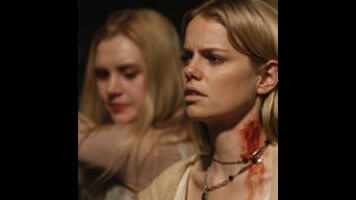Fear Itself: "New Year's Day"

There’s an art to a big twist that few can pull off: You have to keep the big reveal hidden while also having the events before it make sense in retrospect. Oftentimes, as in tonight’s episode of Fear Itself, the filmmakers will concern themselves so much with the former that they don’t worry enough about the latter. So we feel both surprised by a twist we didn’t see coming and a little gypped for being cheated along the way.
Let’s look at the story first: We open during a zombie apocalypse on New Year’s Day. Helen (Briana Evigan) wakes up with a monster hangover and the slow realization that the world she knew when she passed out has changed. There’s blood all over the halls of her apartment building and her sweet landlady is now a dead-eyed, moaning zombie who’s violently pounding her head in the door. Her good friend Eddie has also been infected and starts chasing her around as she tries to find her way out and seek refuge with her boyfriend James. All the while, the infection is spreading rapidly through the city and turning the populace into a cross between the zombies in 28 Weeks Later and the loose-jointed ghouls in J-horror movies.
We also get flashbacks of the evening before, when Helen, Eddie, James, and Helen’s oldest childhood friend are convening for a big “End Of The World” New Year’s Eve blowout. Helen is in a fragile state of mind, still mourning the loss of her brother while reaching out to James, who doesn’t really share her affections. There are some minor twists here about who loves whom and who’s betraying whom, though they’re really setting us up for the big twist, which is that Helen has been a zombie all along.
Am I alone in finding this twist a little head-scratching? The flurry of flashbacks help explain it: The old man blaming Helen for “starting all of this,” the fact that zombie Eddie follows her without ever actually attacking her, and the broken-up cell phone calls, which we might have assumed were the result of typical apocalyptic technical breakdowns, but in fact were because zombies don’t speak so clearly. Yet I’m still inclined to call bullshit on this one, for the simple fact that she acts like a non-zombie all the way up to the reveal. She’s scared, disoriented, doesn’t seem to know what’s going on, and flees from other zombies. And if there’s one thing about zombies, they’re single-minded and purposeful creatures, not the types to hide and second-guess themselves. Am I wrong about this twist being a cheat? I’m willing to consider a counter-argument from someone who was surprised and edified by it.








































